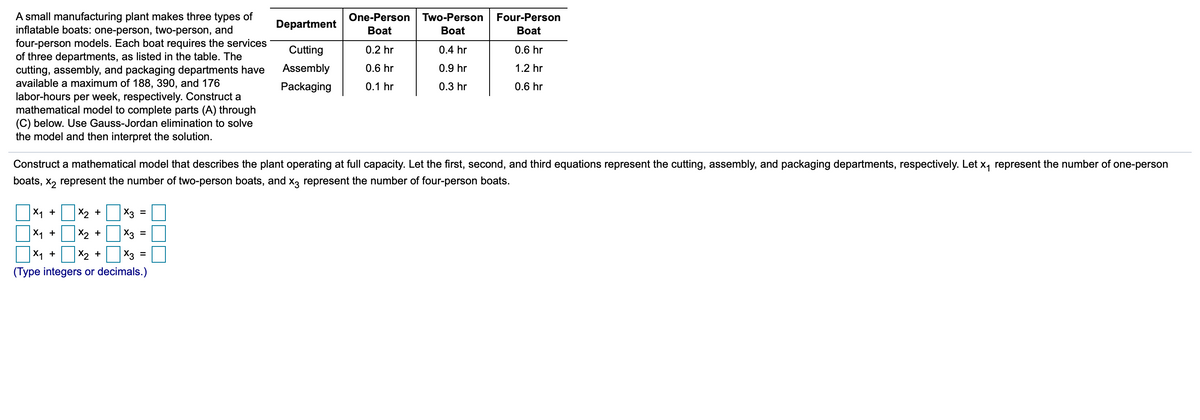One-Person Two-Person Four-Person A small manufacturing plant makes three types of inflatable boats: one-person, two-person, and four-person models. Each boat requires the services of three departments, as listed in the table. The cutting, assembly, and packaging departments have available a maximum of 188, 390, and 176 Department Boat Вoat Вoat Cutting 0.2 hr 0.4 hr 0.6 hr Assembly 0.6 hr 0.9 hr 1.2 hr Packaging 0.1 hr 0.3 hr 0.6 hr labor-hours per week, respectively. Construct a mathematical model to complete parts (A) through (C) below. Use Gauss-Jordan elimination to solve the model and then interpret the solution. Construct a mathematical model that describes the plant operating at full capacity. Let the first, second, and third equations represent the cutting, assembly, and packaging departments, respectively. Let x, represent the number of one-person boats, x2 represent the number of two-person boats, and x3 represent the number of four-person boats. OX1 + OX2 +D X3 = O OX1 +OX2 +D X3 = O OX1 + OX2 +O*3 = D (Type integers or decimals.)
One-Person Two-Person Four-Person A small manufacturing plant makes three types of inflatable boats: one-person, two-person, and four-person models. Each boat requires the services of three departments, as listed in the table. The cutting, assembly, and packaging departments have available a maximum of 188, 390, and 176 Department Boat Вoat Вoat Cutting 0.2 hr 0.4 hr 0.6 hr Assembly 0.6 hr 0.9 hr 1.2 hr Packaging 0.1 hr 0.3 hr 0.6 hr labor-hours per week, respectively. Construct a mathematical model to complete parts (A) through (C) below. Use Gauss-Jordan elimination to solve the model and then interpret the solution. Construct a mathematical model that describes the plant operating at full capacity. Let the first, second, and third equations represent the cutting, assembly, and packaging departments, respectively. Let x, represent the number of one-person boats, x2 represent the number of two-person boats, and x3 represent the number of four-person boats. OX1 + OX2 +D X3 = O OX1 +OX2 +D X3 = O OX1 + OX2 +O*3 = D (Type integers or decimals.)
Algebra for College Students
10th Edition
ISBN:9781285195780
Author:Jerome E. Kaufmann, Karen L. Schwitters
Publisher:Jerome E. Kaufmann, Karen L. Schwitters
Chapter11: Systems Of Equations
Section11.CT: Test
Problem 24CT
Related questions
Question
|
A small manufacturing plant makes three types of inflatable boats: one-person, two-person, andfour-person models. Each boat requires the services of three departments, as listed in the table. Thecutting, assembly, and packaging departments have available a maximum of
188,
390,
and
176
labor-hours per week, respectively. Construct a mathematical model to complete parts (A) through(C) below. Use Gauss-Jordan elimination to solve the model and then interpret the solution. |
Department
|
One-Person Boat
|
Two-Person Boat
|
Four-Person Boat
|
|---|---|---|---|---|
|
Cutting
|
0.2
hr |
0.4
hr |
0.6
hr |
|
|
Assembly
|
0.6
hr |
0.9
hr |
1.2
hr |
|
|
Packaging
|
0.1
hr |
0.3
hr |
0.6
hr |
|
|
|
||||
|
|
||||
|
|
Construct a mathematical model that describes the plant operating at full capacity. Let the first, second, and third equations represent the cutting, assembly, and packaging departments, respectively. Let
x1
represent the number of one-person boats,
x2
represent the number of two-person boats, and
x3
represent the number of four-person boats.|
x1
|
+
|
x2
|
+
|
x3
|
=
|
||||
|
x1
|
+
|
x2
|
+
|
x3
|
=
|
||||
|
x1
|
+
|
x2
|
+
|
x3
|
=
|

Transcribed Image Text:A small manufacturing plant makes three types of
inflatable boats: one-person, two-person, and
four-person models. Each boat requires the services
of three departments, as listed in the table. The
cutting, assembly, and packaging departments have
available a maximum of 188, 390, and 176
labor-hours
One-Person
Two-Person
Four-Person
Department
Вoat
Вoat
Вoat
Cutting
0.2 hr
0.4 hr
0.6 hr
Assembly
0.6 hr
0.9 hr
1.2 hr
Packaging
0.1 hr
0.3 hr
0.6 hr
per week, respectively. Construct a
mathematical model to complete parts (A) through
(C) below. Use Gauss-Jordan elimination to solve
the model and then interpret the solution.
Construct a mathematical model that describes the plant operating at full capacity. Let the first, second, and third equations represent the cutting, assembly, and packaging departments, respectively. Let x, represent the number of one-person
boats, x, represent the number of two-person boats, and x3 represent the number of four-person boats.
X1 +
X2 +
X3 =
X1 +
X2 +
X3
%3D
X1 +
X2 +
X3
%3D
(Type integers or decimals.)
Expert Solution
This question has been solved!
Explore an expertly crafted, step-by-step solution for a thorough understanding of key concepts.
This is a popular solution!
Trending now
This is a popular solution!
Step by step
Solved in 3 steps

Knowledge Booster
Learn more about
Need a deep-dive on the concept behind this application? Look no further. Learn more about this topic, advanced-math and related others by exploring similar questions and additional content below.Recommended textbooks for you

Algebra for College Students
Algebra
ISBN:
9781285195780
Author:
Jerome E. Kaufmann, Karen L. Schwitters
Publisher:
Cengage Learning

Linear Algebra: A Modern Introduction
Algebra
ISBN:
9781285463247
Author:
David Poole
Publisher:
Cengage Learning

Algebra & Trigonometry with Analytic Geometry
Algebra
ISBN:
9781133382119
Author:
Swokowski
Publisher:
Cengage

Algebra for College Students
Algebra
ISBN:
9781285195780
Author:
Jerome E. Kaufmann, Karen L. Schwitters
Publisher:
Cengage Learning

Linear Algebra: A Modern Introduction
Algebra
ISBN:
9781285463247
Author:
David Poole
Publisher:
Cengage Learning

Algebra & Trigonometry with Analytic Geometry
Algebra
ISBN:
9781133382119
Author:
Swokowski
Publisher:
Cengage


Elementary Geometry For College Students, 7e
Geometry
ISBN:
9781337614085
Author:
Alexander, Daniel C.; Koeberlein, Geralyn M.
Publisher:
Cengage,

Algebra: Structure And Method, Book 1
Algebra
ISBN:
9780395977224
Author:
Richard G. Brown, Mary P. Dolciani, Robert H. Sorgenfrey, William L. Cole
Publisher:
McDougal Littell